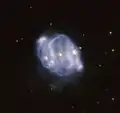| Emission nebula | |
|---|---|
| Planetary nebula | |
.jpg.webp) A false color image of NGC 5307 by the HST | |
| Observation data: J2000 epoch | |
| Right ascension | 13h 51m 3.3s[1] |
| Declination | −51° 12′ 20.7″[1] |
| Distance | 10.55 kly (3.235 kpc)[2] ly |
| Apparent magnitude (V) | 11.2[3] |
| Apparent dimensions (V) | 18.8″[4] |
| Constellation | Centaurus |
| Designations | ESO=221-11[1] |
NGC 5307 is a planetary nebula in the southern constellation of Centaurus, positioned less than 3° to the northeast of the star Epsilon Centauri.[5] It was discovered by English astronomer John Herschel on April 15, 1836. The nebula is located at a distance of approximately 10.6 kilolight-years from the Sun.[2] The central star, designated PNG 312.3+10.5, is a weak emission-line star, superficially similar to the WC subtype of Wolf–Rayet stars.[6] It has a spectral class of O(H)3.5 V.[7]
This is a Type IIb/III[8] planetary nebula with a low expansion velocity of 15 km/s.[9] The chemical abundances in the shell indicate that the progenitor had only undergone partial conversion of carbon into nitrogen when its life span came to an end.[9] The morphology shows point symmetry around the center. Overall it is rectangular in shape, and has two pairs of higher density knots that are symmetric around the middle, aligned along position angles of approximately 30° and 163°. These display a slightly enhanced abundance of nitrogen compared to the rest of the nebula and are photoionized on the side facing the central star.[8] The symmetrical shape of the nebula may have arisen from jets emerging from both sides of a disk about the central star.[10]
Gallery
 NGC 5307 can be seen primarily in the southern hemisphere.[11]
NGC 5307 can be seen primarily in the southern hemisphere.[11]
References
- 1 2 3 "NGC 5307". SIMBAD. Centre de données astronomiques de Strasbourg. Retrieved 2007-04-08.
- 1 2 Stanghellini, Letizia; et al. (December 10, 2008). "The Magellanic Cloud Calibration of the Galactic Planetary Nebula Distance Scale". The Astrophysical Journal. 689 (1): 194–202. arXiv:0807.1129. Bibcode:2008ApJ...689..194S. doi:10.1086/592395. S2CID 119257242.
- ↑ Seligman, Courtney. "New General Catalogue objects: NGC 5300 - 5349". cseligman.com. Retrieved 2020-09-20.
- ↑ Tylenda, R.; et al. (July 2003). "Angular dimensions of planetary nebulae". Astronomy and Astrophysics. 405 (2): 627–637. arXiv:astro-ph/0304433. Bibcode:2003A&A...405..627T. doi:10.1051/0004-6361:20030645. S2CID 118911275.
- ↑ Streicher, Magda (June 2008). "Centaurus, a constellation like no other". Monthly Notes of the Astronomical Society of South Africa. 67 (5 and 6): 95–99. Bibcode:2008MNSSA..67...95S.
- ↑ Weidmann, W. A.; Gamen, R. (July 2011). "Central stars of planetary nebulae. II. New OB-type and emission-line stars". Astronomy & Astrophysics. 531: 11. arXiv:1106.1149. Bibcode:2011A&A...531A.172W. doi:10.1051/0004-6361/201116494. S2CID 118478203. A172.
- ↑ Weidmann, W. A.; et al. (August 2020). "Catalogue of the central stars of planetary nebulae. Expanded edition". Astronomy & Astrophysics. 640: 17. arXiv:2005.10368. Bibcode:2020A&A...640A..10W. doi:10.1051/0004-6361/202037998. S2CID 218763306. A10.
- 1 2 Ali, A.; Dopita, M. A. (August 2017). "IFU Spectroscopy of Southern Planetary Nebulae V: Low-Ionisation Structures". Publications of the Astronomical Society of Australia. 34: 18. arXiv:1707.09650. Bibcode:2017PASA...34...36A. doi:10.1017/pasa.2017.30. S2CID 109929493. e036.
- 1 2 Ruiz, María Teresa; et al. (September 2003). "Very Large Telescope Echelle Spectrophotometry of the Planetary Nebula NGC 5307 and Temperature Variations". The Astrophysical Journal. 595 (1): 247–258. arXiv:astro-ph/0305348. Bibcode:2003ApJ...595..247R. doi:10.1086/377255. S2CID 18290113.
- ↑ Bond, Howard E. (2000). "Binarity of Central Stars of Planetary Nebulae". In Kastner, J. H.; Soker, N.; Rappaport, S. (eds.). Asymmetrical Planetary Nebulae II: From Origins to Microstructures. Asymmetrical Planetary Nebulae II: From Origins to Microstructures. ASP Conference Series. Vol. 199. p. 115. arXiv:astro-ph/9909516. Bibcode:2000ASPC..199..115B. ISBN 1-58381-026-9.
- ↑ "A Passing Fancy". www.spacetelescope.org. Retrieved 26 August 2019.